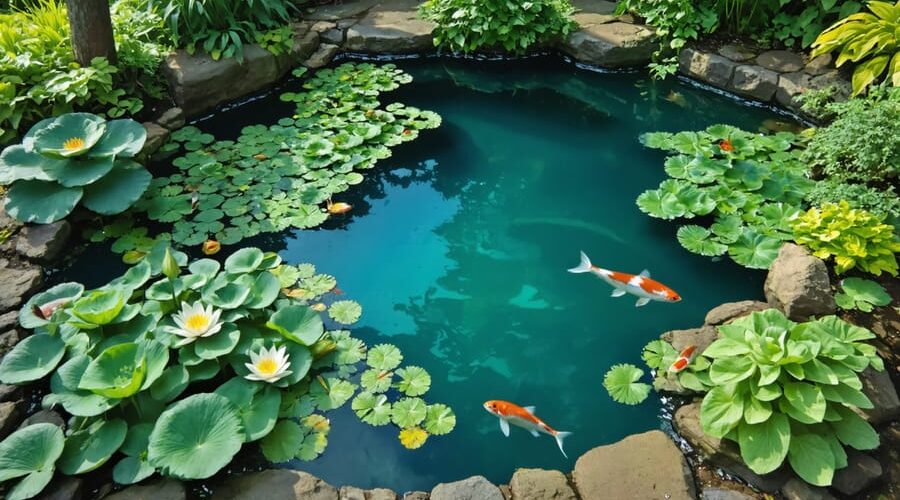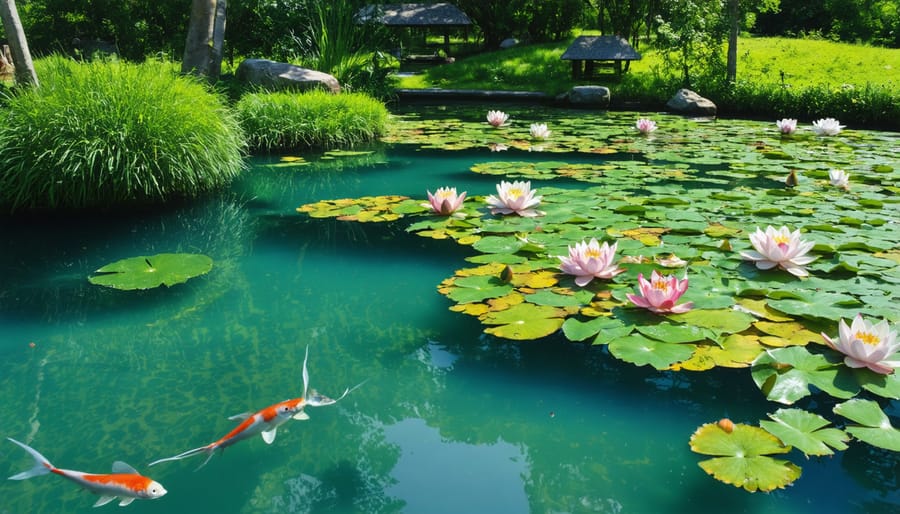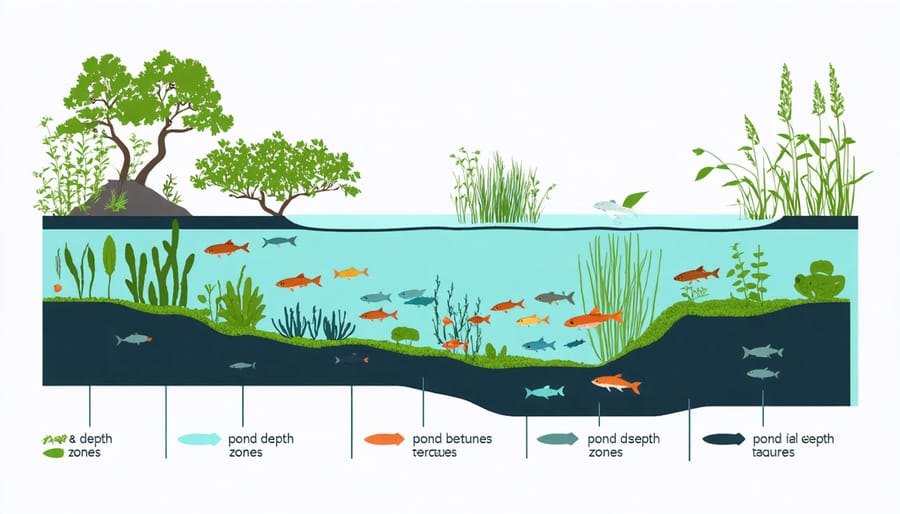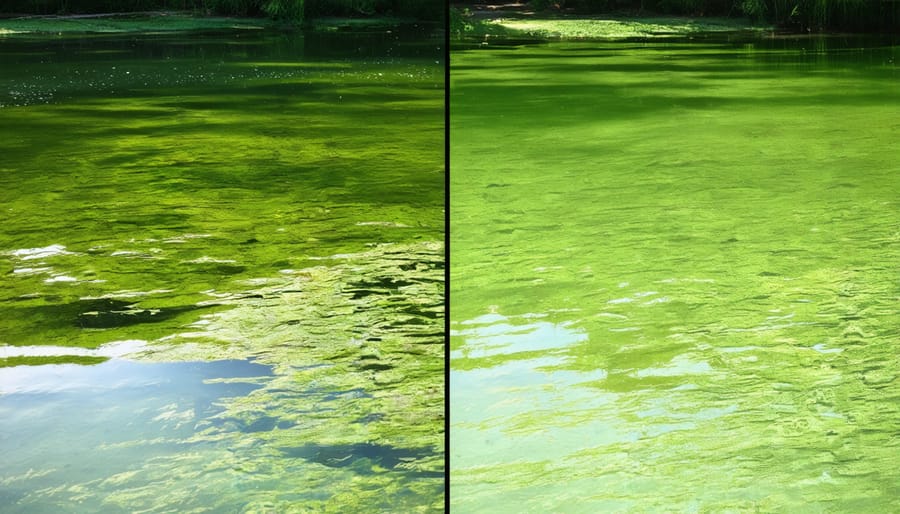
Create a Self-Sustaining Pond That Practically Maintains Itself
Create a thriving ecosystem in your backyard by establishing a self-regulating pond that maintains its own biological balance. Through strategic natural pond design, proper plant selection, and careful species integration, your water feature can flourish with minimal human intervention. Just as nature’s wetlands sustain themselves through intricate relationships between plants, animals, and microorganisms, a well-designed backyard pond becomes a living system that filters its own water, controls algae growth, and supports diverse aquatic life.
Think of your pond as a miniature world where every element plays a crucial role – submerged plants oxygenate the water, floating vegetation provides shade and shelter, while beneficial bacteria break down organic matter. This delicate balance, once established, creates a self-perpetuating cycle that not only maintains water clarity but also attracts local wildlife, from dragonflies to songbirds, transforming your garden into a vibrant sanctuary of biodiversity.
By embracing natural principles and working with ecological processes rather than against them, you’ll create more than just a water feature – you’ll establish a resilient aquatic ecosystem that improves with age and requires less maintenance over time.
Natural Balance: The Key to Self-Sustaining Ponds

The Perfect Plant-to-Water Ratio
Creating a balanced aquatic ecosystem starts with getting the right proportion of plants to water surface area. A good rule of thumb is to cover about 60-70% of your pond’s surface with vegetation, leaving the remaining space open for water circulation and fish movement. This golden ratio helps prevent algae overgrowth while maintaining enough oxygen levels for all pond inhabitants.
Think of your pond as a living room – you want enough furniture to make it functional and beautiful, but not so much that you can’t move around! Different types of plants serve different purposes: floating plants provide shade and absorb excess nutrients, while submerged plants oxygenate the water. Marginal plants along the edges help filter water and create natural transitions.
For every 1 square meter of pond surface, aim to include 2-3 floating plants, 3-4 submerged plants, and 4-5 marginal plants. This combination ensures your pond maintains its balance naturally, requiring less intervention from you. Remember to adjust these numbers based on your specific climate and pond conditions.
Fish and Microorganism Communities
A healthy pond ecosystem relies on a diverse community of fish and beneficial microorganisms working together. Fish like koi and goldfish not only add beauty but also help control mosquito larvae and excess plant growth. Consider including bottom-feeders such as weather loaches or plecos, which naturally clean up debris from the pond floor.
Beneficial bacteria are the unsung heroes of a self-sustaining pond. These microscopic workers break down fish waste, fallen leaves, and other organic matter into nutrients that plants can use. Some bacteria convert harmful ammonia into less toxic substances, while others help keep algae growth in check.
To support these helpful organisms, avoid overcrowding your pond with fish (a good rule is one inch of fish per 10 gallons of water) and resist the urge to over-clean. A thin layer of organic matter on the bottom provides a home for beneficial bacteria. Adding pond-specific bacterial supplements during spring startup can help jumpstart the biological filtration process and maintain clear, healthy water throughout the season.
Remember, a balanced ecosystem takes time to develop, so be patient as these natural communities establish themselves.
Essential Design Elements for Long-Term Success

Depth Zones and Their Purpose
A well-designed self-sustaining pond requires carefully planned depth zones, each serving a specific purpose in maintaining the ecosystem’s balance. The shallow marginal zone, typically 0-6 inches deep, provides essential space for bog plants and beneficial microorganisms. This area also creates safe spots for wildlife and helps filter water naturally.
Moving deeper, the medium-depth zone (12-24 inches) is perfect for most aquatic plants and aesthetic pond features like small fountains or waterfalls. This zone helps maintain stable water temperatures and supports a diverse range of pond life.
The deep zone, reaching 24-36 inches or more, is crucial for fish survival during extreme weather conditions. It provides a cool refuge in summer and prevents freezing in winter. This area also helps stabilize water chemistry and reduces algae growth by limiting light penetration to the bottom.
For optimal pond health, aim to incorporate all three zones with approximately 30% shallow, 40% medium, and 30% deep areas. This distribution creates natural transitions between zones and supports a wider variety of aquatic life. Remember, even small ponds benefit from having distinct depth zones, though their proportions might vary based on your specific needs and available space.
Natural Filtration Systems
Natural filtration systems are the heart of a self-sustaining pond, working tirelessly to keep your water clean and healthy. The key is creating layers of biological filtration that mimic nature’s own cleaning processes.
Start with a dedicated plant filter zone where water-loving plants like cattails, rushes, and iris can thrive. These plants aren’t just beautiful – their roots act as natural filters, absorbing excess nutrients and providing homes for beneficial bacteria. Consider adding water hyacinths or duckweed as floating plants, which help shade the water and reduce algae growth.
Creating a gravel bed at the bottom of your pond provides another natural filtration layer. The small spaces between stones become home to colonies of beneficial bacteria that break down waste and maintain water quality. For best results, use different sizes of gravel, from larger rocks at the bottom to finer pieces on top.
Don’t forget about submerged plants like hornwort or anacharis. These underwater workhorses oxygenate the water and compete with algae for nutrients. A good rule of thumb is to cover about 60% of your pond’s surface with plants, balancing between floating, marginal, and submerged varieties.
For enhanced filtration, consider creating a small wetland area or bog garden at the pond’s edge. This natural filter will process water as it flows through layers of gravel and plant roots, returning clean water to your pond while adding an attractive feature to your garden.
Water Circulation Techniques
Effective natural water circulation is the heart of any self-sustaining pond. While traditional ponds often rely heavily on mechanical pumps, a well-designed ecosystem can minimize the need for artificial circulation. The key is to work with nature rather than against it.
Start by incorporating different depth zones in your pond design. Deeper areas naturally create temperature differences, which promote water movement as warmer water rises and cooler water sinks. This thermal circulation helps distribute nutrients and oxygen throughout your pond.
Strategic placement of plants can enhance water movement too. Underwater plants create gentle currents as they photosynthesize and release oxygen bubbles. Surface plants like water lilies provide shade, which helps establish temperature gradients that encourage natural flow.
While you might still need a small pump, it doesn’t have to run continuously. Consider using a solar-powered pump that operates during daylight hours, or a timer-controlled system that runs for just a few hours daily. Position the pump’s outlet to create a gentle ripple rather than a forceful jet – this mimics natural movement and helps oxygenate the water while being gentler on pond life.
Remember, gentle circulation is often more beneficial than strong currents. Too much movement can stress fish and disturb beneficial bacteria that help maintain your pond’s ecosystem.
Seasonal Care and Minimal Maintenance
Spring and Summer Management
As temperatures rise and daylight hours increase, your pond naturally becomes more active. Spring is the perfect time to trim back any dead vegetation and remove debris that accumulated over winter. Check your plants for new growth and divide any overcrowded species to maintain healthy plant populations.
Monitor water levels more frequently during warmer months, as evaporation increases. Top up the pond when needed, preferably using rainwater or aged tap water to maintain proper water chemistry. Keep an eye on algae growth, which tends to spike during spring. Adding more floating plants can help shade the water and reduce algae naturally.
Summer brings increased biological activity, so watch for signs of oxygen depletion, especially during hot spells. Running a small fountain or waterfall during the hottest parts of the day can help boost oxygen levels. Consider installing shade sails or encouraging taller marginal plants if your pond receives too much direct sunlight.
Feed fish sparingly during these active months – they’ll find plenty of natural food in a well-balanced pond ecosystem. Remove any yellowing or dead plant material promptly to prevent excess nutrient buildup. Regular visual checks of your pond’s inhabitants and water clarity will help you spot and address any issues before they become problems.
Remember that a truly self-sustaining pond requires patience – resist the urge to over-manage, and let nature find its balance.
Winter Preparation
As winter approaches, preparing your self-sustaining pond for cold weather is crucial for maintaining its delicate ecosystem. Start by trimming back any dying aquatic plants and removing fallen leaves before they sink and decompose. A pond net stretched across the surface can catch falling leaves and make this task much easier.
If you live in a region where the pond might freeze, it’s essential to keep a small area of the surface ice-free. This allows for proper gas exchange and ensures fish can breathe. A floating de-icer or pond aerator can help maintain this crucial opening without disturbing the warmer layers below where fish hibernate.
Don’t completely clean out your pond before winter – the natural debris at the bottom provides important shelter for hibernating creatures. However, do remove enough plant matter to prevent excess decomposition, which could harm water quality.
For fish safety, gradually reduce feeding as temperatures drop. When water temperatures consistently fall below 50°F (10°C), stop feeding entirely, as fish enter a natural state of dormancy and can’t properly digest food.
Consider adding cold-hardy beneficial bacteria to help maintain water quality throughout winter. These specially adapted microorganisms continue working at lower temperatures, helping to break down organic matter and maintain the pond’s biological balance even during the cold months.
Troubleshooting Common Issues
Water Quality Concerns
Maintaining crystal-clear water in your pond doesn’t require harsh chemicals or constant intervention. Nature has provided us with amazing solutions to common water quality issues. One of the most effective approaches is creating a balanced ecosystem with aquatic plants that act as natural filters. Water lilies and floating plants like duckweed help reduce algae growth by limiting sunlight penetration, while submerged plants like hornwort actively absorb excess nutrients.
For cloudy water issues, beneficial bacteria play a crucial role. These microscopic helpers break down organic matter and help maintain healthy water conditions. You can encourage their growth by adding clay-based bottom substrate and ensuring proper oxygenation through gentle water movement.
Green water problems typically stem from excess nutrients and sunlight. Installing a UV clarifier can help, but natural solutions like adding more plants or introducing filter-feeding fish like koi can be equally effective. Remember that some algae is natural and beneficial – it’s about finding the right balance.
If you notice foul odors, this usually indicates poor oxygen levels or excess organic matter. Adding an air pump or creating a small waterfall can increase oxygen levels naturally. Regular removal of fallen leaves and periodic trimming of dead plant material will prevent organic buildup without disturbing the pond’s natural balance.
Monitor your water quality regularly, but be patient – a truly self-sustaining pond takes time to establish its natural equilibrium.

Algae Management
Maintaining healthy algae levels in your self-sustaining pond doesn’t require harsh chemicals. Instead, focus on natural solutions that work with your pond’s ecosystem. Start by introducing floating plants like water lilies and duckweed, which shade the water and compete with algae for nutrients. Aim to cover about 60-70% of your pond’s surface with these plants.
Adding submerged oxygenating plants like hornwort or anacharis helps too. These plants release oxygen into the water and absorb excess nutrients that algae would otherwise use to grow. A good rule of thumb is to include one bunch of oxygenating plants for every 2 square feet of surface area.
Beneficial bacteria are your allies in algae control. These microscopic helpers break down organic matter and compete with algae for nutrients. You can encourage their growth by adding barley straw or natural bacterial supplements during spring and summer months.
Creating a balanced fish population also helps manage algae. Fish like koi and goldfish eat some types of algae, but don’t overstock – too many fish produce excess waste that can fuel algae growth. A general guideline is one inch of fish per 10 gallons of water.
Remember that some algae is natural and beneficial. The goal isn’t to eliminate it completely but to maintain a healthy balance. Regular monitoring and gentle intervention with these natural methods will help keep your pond clear and vibrant without disrupting its natural ecosystem.
Creating a self-sustaining pond is not just about building a water feature; it’s about crafting a living ecosystem that brings nature closer to home. By following the principles we’ve discussed – from proper design and plant selection to maintaining natural balance – you can create a thriving aquatic environment that practically takes care of itself. Remember, success doesn’t happen overnight, but with patience and careful attention to the ecosystem’s needs, your pond will develop into a beautiful, low-maintenance oasis. Whether you’re a beginner or an experienced gardener, starting your self-sustaining pond journey is a rewarding endeavor that connects you with nature while adding lasting value to your outdoor space. Take that first step today, and watch as your pond becomes a vibrant hub of natural activity.
